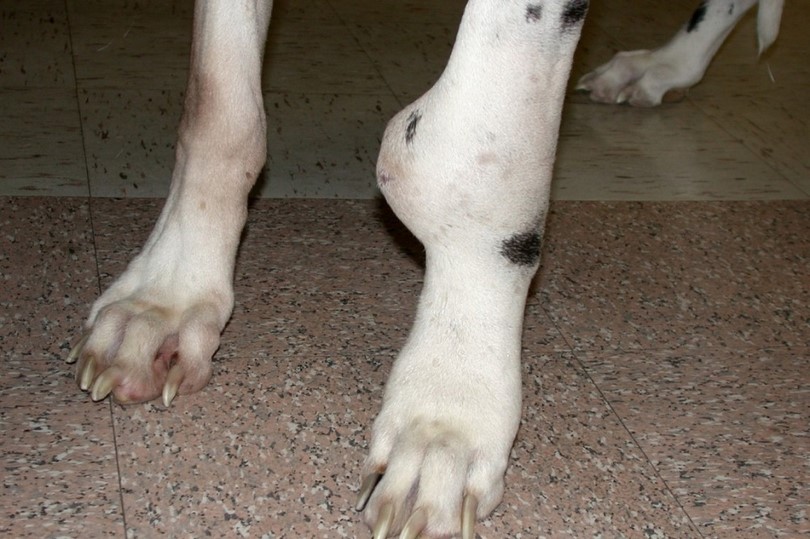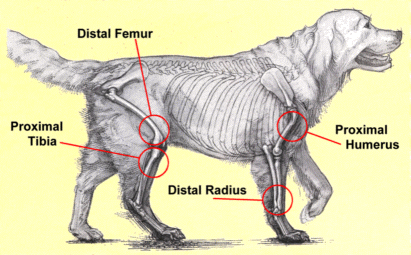Understanding and Successfully Treating Osteosarcoma in Dogs
Osteosarcoma is the most common type of bone cancer found in dogs, more prone to develop in larger breeds in their mid to late years, however there’s been an increase in younger dogs developing this disease in recent years.
Canine osteosarcoma can develop anywhere in the skeletal structure, but is more commonly found in the legs, and where previous trauma or injury have occurred. Osteosarcoma of the limbs is referred to as appendicular osteosarcoma accounting for 75-85% of all bone cancer found in dogs.
Tumorous bone is not as strong as a healthy bone, and as a result the propensity for bones to incur further fractures or breaks are greatly increased. Referred to as Pathological fractures, these injuries don’t have the ability to properly heal, further complicating the condition.
 Osteosarcoma develops deep within the bone and becomes progressively more painful as it grows outward, destroying the bone from the inside out.
Osteosarcoma develops deep within the bone and becomes progressively more painful as it grows outward, destroying the bone from the inside out.
Unfortunately osteosarcoma tumors are highly aggressive and metastatic in nature. By the time of diagnosis, most cases have experienced metastasis to other areas.
Hormones are considered an inhibitor of canine osteosarcoma, as spayed females are 34% more likely to develop the disease and neutered males are 65% more likely.
Main Causes for Osteosarcoma in Dogs
Clinically speaking, there’s no conclusive cause for osteosarcoma in dogs, however when analyzing the cases, different studies and test groups, there’s some strong indications as to the causes.
Many types of canine cancer have been on the rise in recent years and improper diet has been considered to be a major factor. With canine osteosarcoma, diet is considered to have a direct effect on the integrity of the skeletal structure, which intern opens the door for disease.
Commercially processed foods that are high in carbohydrates are commonly thought to promote rapid growth in puppies. This rapid rate of growth adversely affects the density of the bones. When the bone density and integrity are breached, fractures and injuries are more likely to occur. Studies have shown that many cases of osteosarcoma in dogs develop in areas of previous injury or trauma.
 Diets that cause rapid growth in puppies, and malabsorption during a dogs growing stage can result in poor bone density, making them more prone to develop osteosarcoma.
Diets that cause rapid growth in puppies, and malabsorption during a dogs growing stage can result in poor bone density, making them more prone to develop osteosarcoma.
Diagnosis
A complete orthopedic and neurologic examination, physical examination, and regional radiographs (x-rays) are generally the the firsts to determine the condition and stage of the disease. If an obvious tumor is observed, then a bone biopsy may be performed to obtain a definitive diagnosis.
A bone biopsy can be a challenging procedure with the risk of fracturing the bone as well as spreading the cancer thought the biopsy pathway.
Unfortunately, by the time osteosarcoma in diagnosed, the cancer has usually spread to the lungs in most cases. An x-ray of the chest may be performed to help determine if the cancer has spread to the chest, however because of the initial small size of the metastasis it can be hard to confirm.
Prognosis
The average survival in dogs with osteosarcoma treated with surgery and chemotherapy is less than one year. For dogs younger than seven years of age with large tumor located in the proximal humerus, the prognosis is less than six months.
In axial osteosarcoma, the medial survival rate is 4-5 months due to the fact that the location makes complete surgical removal not possible, so recurrence of the disease is likely.
Symptoms of Osteosarcoma in Dogs
- Inflamation of the limbs
- Lameness
- Loss of appetite (anorexia)
- Weight loss


Canine Osteosarcoma and diet
Diet is extremely important when treating any type of canine cancer but even more so with Osteosarcoma, as diet is often a factor in the development of this type of cancer.
Creating a powerful canine cancer diet that promotes cell rejuvenation and bone density, while boosting the immune system to combat cancer is imperative for sustainable long term success.

Conventional Treatments for Osteosarcoma in Dogs
If surgical removal of the affected area is considered possible, then surgery combined with chemotherapy is often used as a supplement to any surgical options to ensure that the disease has not spread into other areas of the dog’s body, particularly the lymph nodes and lungs.
In more severe cases, limbs may need to be amputated as an attempt to completely remove the bone cancer, or to alleviate pain and lameness.
Limb sparing surgery is a procedure that replaces a diseased area of bone with a metal implant, or bone graft from another dog (allograft), or a combination of bone graft and metal implant (allo prosthetic composite). Implant failure occurs in approximately 10% of cases resulting in local tumor recurrence, and infection.
Unfortunately, due to the degree of metastasis that’s often present at the time of diagnosis, and the overall complications of this type of cancer, most conventional treatments aim at simply increasing the quality of life not achieving long term remission.
Surgery, combined with chemotherapy drugs such ascisplatin, carboplatin, or doxorubicin are used, as well as additional medication to control pain are generally the protocol for most cases.
Holistic Treatments for Osteosarcoma in Dogs
Holistic Veterinarians and health practitioners seem to have a little better understanding of the philosophy of “treating the patient not just the disease”. They tend take into account the unique circumstances of that particular dog, as well as what’s leading to the illness or disease.
A tumor or any disease is the result of an underlying issue (the cause). That issue needs to be addressed in order achieve and maintain remission. This along with promoting the body’s ability to heal itself, are the main aspects of holistic approaches.
It’s important to understand that many conventional treatments do have some undeniable benefits, but they also have their limitations. To fully realize their potential, they must combined with a holistic approach that promotes health as well. Otherwise, the initial cause and the bodies inability to heal itself are constantly working against the treatment.
Dietary factors are thought to be a contributor in the development of Osteosarcoma in dogs, so it’s imperative to correct these dietary habits and replace them with a canine cancer diet treatment that can help to promote a healthy immune system and cell rejuvenation.
The body has a remarkable ability to heal itself. In fact, it’s only the body and the immune system that can heal itself. This fundamental aspect of nature must be recognized and honored by promoting its ability to heal. Only then do we have the highest chance at attaining and maintaining remission.
Is it a Case of Faulty Genes?
In the vast majority of cases, absolutely not. Some types of cancer are more common it certain breeds and larger breeds such a Great Danes, Irish Setters, Doberman Pinschers, Rottweilers, German Shepherds and Golden Retrievers have a predisposition for osteosarcoma. However, it’s important to understand that predisposed does not mean predetermined! Genetics are a factor, but there are many other factors as well.
For cancer, or any disease to develop, a dysfunction in the immune system must be present. So by addressing this area, we can greatly reduce illness regardless of what genetic challenges a certain breed has.
All that being said, when a breed is more predisposed, this simply means that when something is challenging the immune system, this is the weakest link that we often find the effects first.
Many dogs have these same “weak links” or challenges and go on to live a healthy full lives, while some unfortunately do not. Genes are merely blueprints, and it’s how well these these blueprints are properly built upon and maintained that makes the difference.
Larger breeds have more weight on their limbs to support, and as a result the health and integrity of their skeletal structure is of extreme importance. If optimal health is not present, then this challenge can result in the development of disease.




